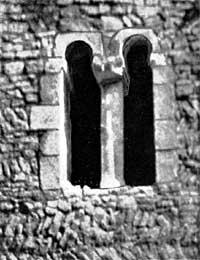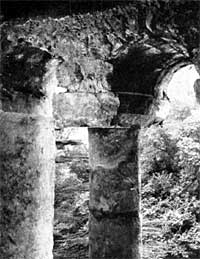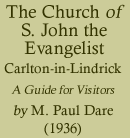THE parish church of S. John the Evangelist, Carlton-in-Lindrick, is the only church in all Nottinghamshire which has an Anglo-Saxon tower and any extensive remains of the Saxon age, and it is one of the only three in the county which contain any true Saxon work at all, except fragments of sculpture. So rare is such work that this is a priceless heritage.
It is hoped that this little sketch of the church's story may be found of interest, even by those visitors who know little or nothing of ecclesiastical architecture, especially as this is one of those village churches in which the visitor, instead of having to dodge hither and thither to find the various features of the building in chronological order, is able to see how it grew up, age by age, by going round the church clockwise, starting with the tower and working round to his starting-point.
All good antiquaries inspect the exterior of a church before its interior, for the outside tells them much. It is not a bad plan for the non-expert visitor to follow, and at Carlton, indeed, one must begin with the exterior of the tower in order to see the earliest features of the building.
First, however, a word is necessary as to why this somewhat remote village, tucked away in a northern corner of the county, should have possessed, as from the evidence of the extant tower it did, a remarkably fine stone church over a thousand years ago—for its earliest parts may safely be dated before 860 A.D.—instead of the combustible erection of daub-and-wattle more commonly set up at first.
The great " income-tax inquisition " of the Normans, Domesday Book (1086), unlocks the secret of why there was at Carlton a fine, substantial stone structure, for it tells us that in the time of Edward the Confessor (1042-1066), " in Carletune six thegns had each a hall "—an unusually large number of Saxon landowners to be found in one place—and mentions the existence of the church.
There were thus at Carlton what corresponded to six manors. None of them could have been very large, and they were all close together ; in fact, after the Conquest they became united into one manor, held of the King by Roger de Busli, and under him by Turald de Chevrolcourt. Now, it has been established that the early Saxon parish churches were in the first instance chapels built to serve the estates of the landowners, and actually followed the form of the lord's "hall," which consisted of a long outer hall and, at one end of it, an inner hall for privacy. To this the nave and chancel of the church corresponded. There can be no doubt that the landowners collectively agreed to have a joint church at Carlton instead of the usual small shack that would be found on one isolated manorial holding.
It cannot be supposed that the six holdings suddenly appeared together out of the blue just before 1066. If we allow five generations, that only carries us back to about 850, and it is quite reasonable to assume that this land-distribution was then in existence.
The tower exterior

THE TOWER WEST FACE, SHOWING REOPENED SAXON DOUBLE WINDOW
We can now begin our survey of how the present building grew up. The visitor should begin with the outside of the tower. Here the first feature which strikes one is the particularly fine mid-Norman door ; but as it is a later insertion, not in its original position, we will leave it for the moment and imagine in its place a much smaller, narrower and cruder doorway which would be the only entrance into the Saxon church, with probably a small, round-headed window above, which has given place to the present later window.
Inspecting the walls of the tower, we find that its masonry in the second floor, on all faces, consists largely of stones laid in a curious manner, at a sloping angle instead of flat. This is appropriately called " herring-bone " masonry, and is typical of Saxon work, though it does occasionally survive into early Norman walling.
At later periods, the tower has been considerably tampered with, as regards its surface, both inside and out, but there is proof that it was " rebated," i.e., had the lower stages thicker than the upper, as now, when it was first built. The evidence is a course of herring-bone work left undisturbed at the foot of the south wall. It only came to light in August this year, when a mass of undergrowth was cleared out.
Forty feet up in the second storey, in each of the north, east and south faces, surrounded by the herring-bone masonry, will be seen a blocked-up window of two lights, each very narrow and having a semi-circular head. The side-jambs of the windows show another characteristic of Saxon work called " long and short," a name which is obvious when one observes how the blocks forming the facings are laid. The outside end of the huge central impost between the lights—one long block of dressed ashlar running the whole three-feet thickness of the walls—can be seen at the join of the two heads.
A romantic discovery

SAXON WINDOW AND HERRINGBONE WORK, TOWER WEST FACE.
 SAXON WINDOW, TOWER WEST FACE, AFTER OPENING, INTERIOR.
SAXON WINDOW, TOWER WEST FACE, AFTER OPENING, INTERIOR.The window in the west face is no longer blocked up, and thereby hangs the tale of a recent romantic discovery. In preparation for the compilation of this guide, the present writer, in company with the rector, naturally made a thorough survey of the building. Groping in the clock-chamber of the tower, in studying first the indications of Saxon work, we observed that one of the original Saxon shafts, which in each window divides the two lights, remained, sadly mutilated by clock machinery, in the south face—the only one of the windows that was not entirely blocked up.
All the other windows were completely filled up with rubble and plastered over, with only a few suspicious bulges showing through the plaster— but to the trained architectural eye a bulge in the right place is enough. Here these projections hinted clearly that we should find the original inner face and jambs of the windows. So we next squinted into a square ventilation hole cut through the rubble filling of the eastern window, and, embedded in the middle of it, we caught a glimpse of the central circular pillar, apparently undamaged.
The rector and wardens consented to a practical exploration of the west window, this being the most accessible, and were well rewarded for making the experiment, for we have been able to expose the whole window, with its great central impost and the splayed barrel-roofs of the two lights, the dressed blocks of ashlar at the spring of the heads, and the jamb facings, all intact. Aided considerably by Mr.W. Newstead and other volunteers, the rector and I have dug out, inch by inch, 90 cubic feet of poor rubble and mortar in which the window has been embedded for five centuries.
It seems that when a benefactor named William de Chaumbre, the historian and biographer, who was rector from 1417 to 1443, and of whom we shall speak later, gave his church a bell (still extant*), his masons, erecting the present top stage of the tower to house it, thought the Anglo-Saxon structure did not look strong enough to carry the extra weight, and, after filling in these four tower windows, stuck buttresses on to the western corners of the tower. They made a poor job of the filling, but we must be grateful to them for the accidental preservation of what might otherwise have been lost ; their mortar was all sand, and fell away easily from the Saxon work. Doubtless the north and east windows also preserve their features intact and may later be opened up. It is worth noting in passing that the Anglo-Saxon herring-bone work would not be left " stripped " as at present. The Saxons plastered their surfaces. It is only because some later plastering was removed 68 years ago that it was possible to realise the whole tower was pre-Norman work.
* It is inscribed : VIRGINIS EGREGIAE VOCOR CAMPANA MARIE DOS WILLS CHAWMBYR.
